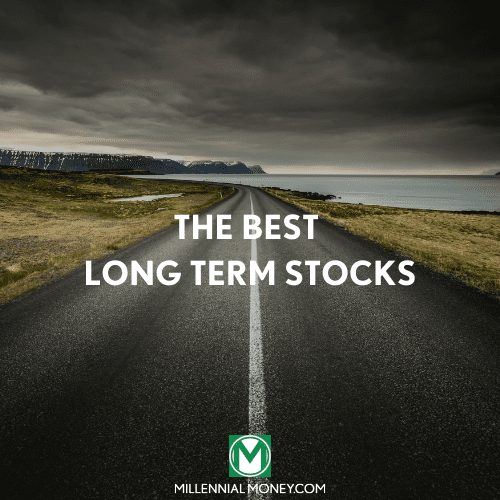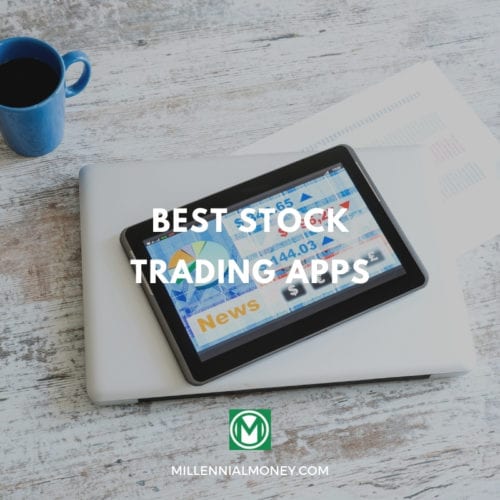Stock and investment newsletters are a great way for investors to get new ideas, access the latest news, and make different investing decisions.
They can help you get all the information you need about investing in one place, but shouldn’t ever replace your own due diligence.
Here are all of my best tips on investment newsletters and how to pick the best one for you.
14 Best Stock and Investment Newsletters
Take a look at my list of the best stock and investment newsletters you can subscribe to today:
- Motley Fool Stock Advisor
- Motley Fool Rule Breakers
- Seeking Alpha
- Seeking Alpha Alpha’s Pick
- MorningStar
- Benzinga Options
- Zacks Investment Research
- Trade Ideas
- Tim Alerts
- The Maley Report
- The Daily Upside
- Mindful Trader
- Nate’s Notes
- Kiplinger
1. Motley Fool Stock Advisor
Cost: $199/year
Motley Fool Stock Advisor is for retail investors looking for experts to tell them which stocks to add to their portfolio.
Motley Fool Stock Advisor is best for buy-and-hold investors looking for a long-term investment strategy. They recommend you hold most stocks for at least five years.
Stock Advisor recommends mostly large-cap, well-known companies. You’ll receive suggestions for your starter portfolio, two stock picks a month, and ‘buy now’ stocks as they come up in the market.
You’ll also receive plenty of research and analyses to back up the reasons they suggest you invest in certain stocks and access a large community of like-minded investors.
2. Motley Fool’s Rule Breakers
Cost: $299/year
The Motley Fool Rule Breakers newsletter is for the more aggressive investor looking to make changes and invest in emerging markets and companies.
Motley Fool Rule Breakers is best for growth investors who want more than a buy-and-hold strategy but instead want to invest in emerging markets and companies. This isn’t a newsletter for the most popular stocks. Instead, it includes those with the chance to outperform its competitors.
Rule Breakers recommends up-and-coming companies; for example, when they first started, they recommended Amazon, which was new to the market and whose performance today speaks for itself.
Investors receive a list of starter stocks that are essential to every Rule Breaker’s portfolio, then investors receive two stock picks each month and give ‘must buy now stocks.’ In addition, all stock recommendations come with research and analyses to help you understand why you should add them to your portfolio.
Disclaimer: This article is outdated. Rule Breakers may no longer be available. Learn more about the Motley Fool’s Epic service page.
3. Seeking Alpha
Cost: Free – $2,400/year
Seeking Alpha is a newsletter for advanced investors looking for high-level research and information for investment decisions.
Seeking Alpha has three programs:
- Basic: Provides basic updates and research and limited content
- Premium ($189/year + 7 day free trial): Provides unlimited access to content, quant ratings, and dividend grades
- Pro ($2,400/year): Provides everything from Premium plus VIP service, more advanced screeners, and Pro content
It is best for investors looking for real-time advice from expert investors and professionals.
Seeking Alpha provides newsletters and articles written by financial professionals. If you pay for the subscription, you’ll have access to author ratings, so you know how to use the information. Receiving different opinions from various authors can help you form your opinions about what to include in your portfolio.
You’ll also have access to the following:
- Fundamental analysis tools
- Debates
- Real-time market data
- Ongoing newsfeeds
4. Seeking Alpha’s Alpha Pick
Cost: $89/year for the first year, then $199/year
Seeking Alpha’s Alpha Pick helps investors find the top two ‘alpha stocks’ with the greatest chance at top performance that month.
Seeking Alpha’s Alpha Pick is best for investors looking for data-driven stock picks provided to them monthly. It’s a consistent newsletter to help you beat the market with picks based on extensive research.
Seeking Alpha’s Alpha Pick provides two new stocks each month to buy and hold for at least two years. You’ll receive detailed analyses regarding why you should choose those investments and up-to-the-minute updates if anything changes.
The recommendations are based on the following criteria:
- Stocks with a market cap of $500 million or higher
- Stock price of at least $10
- High quant rating for 2 ½ months
- Be the highest-rated stock at the time, but not recommended in the last year
5. MorningStar
Cost: $34.95/month or $249/year
Morningstar is a household name for investors, providing a unique viewpoint for investors. It may be what you need if you’re looking for a different opinion than what Wall Street investors offer.
It is best for fundamental investors who rely on information other than what everyone else is doing. They provide the research and tools to make your own decisions, building a portfolio that’s what you want and not just what other investors do.
The Morningstar newsletter offers independent analyses, simple-to-use ratings, robust stock screeners, pre-filtered investment lists, and a Portfolio X-Ray that gives a 360-degree review of your portfolio based on the following:
- Asset allocation
- Fees
- Sector weights
- Stock stats
You can view all your accounts in one dashboard, and receive personalized insights and curated watchlists.
Use the link above to get $50 off your first year!
6. Benzinga Options
Cost: $97/year
Benzinga Options is run by a professional options trader with significant success trading options. With this subscription, you’ll learn how to trade options and ramp up your efforts to trade like the pros.
The Benzinga Options newsletter is best for anyone interested in trading options, especially day traders and experienced investors. However, this can be a great way to start, even if you’re learning about trading options.
Investors receive the top options picks along with an explanation and analysis so you understand why they are the top picks. In addition, the newsletter aims to help you pick your own options trades.
You’ll receive picks twice a month with the ideal price and expiration date, plus plenty of education on becoming a successful options trader.
7. Zacks Investment Research
Cost: $249/year
Investors who want daily updates and input on investing enjoy Zacks Investment Research premium subscription.
Zacks is best for active investors who want a daily debriefing of what’s happening in the market to make investment decisions.
Zack’s Investment Research provides a free daily newsletter, quotes, charts, portfolio tracker, and asset rankings. The premium subscription also includes equity research reports, more stock screeners, and exclusive commentary to help with your investing decisions.
8. Trade Ideas
Cost: $84 to $167/month
Trade Ideas is an advanced stock scanner for DIY investors. They focus on unusual trade activity, so you won’t get the typical stock picks from this service. Instead, the stock trading app is great for beginners looking to DIY their investments, and you also get access to a simulated platform that trades in real-time to try your strategies.
Trade Ideas is best for the active trader who wants real-time alerts on stocks and other investments with unusual activity that might offer a higher return.
Subscribers receive five weekly trading ideas and a ‘Trade of the Week’ newsletter highlighting one stock you might want to consider. All ideas include the rationale behind the pick to determine if it’s a good choice.
Both subscriptions include real-time alerts, a live trading room, simulated trading, and simultaneous charts. More advanced investors may want the premium option that includes risk assessment, backtesting, and an A.I. virtual trading assistant.
9. Tim Alerts
Cost: $74.95/month to $149.95/month
Tim Alerts is a newsletter from a self-made millionaire who earned his claim to fame on penny stocks, and now he shares his knowledge.
Tim Alerts is only for day traders (penny stock traders). While you might not make it as fast as he did, he’ll show you the ropes if active trading interests you.
Tim Skyes provides weekly educational videos to help you understand the ins and outs of penny stock trading if you subscribe to the premium version.
Otherwise, you’ll receive a list of 5 to 10 stocks to add to your watchlist daily, real-time push alerts, and access to the chatroom to talk with other investors.
10. The Maley Report
Cost: $49/month
The Maley Report is for investors who want a technical and fundamental analysis of their stock picks. All advice provided is actionable to help investors create the portfolio they desire.
The Maley Report is best for advanced investors who want in-depth technical, macro, and fundamental analyses. Matt Maley spent 35 years on Wall Street before sharing his expertise with investors, and he now provides a full picture of the market to help investors make decisions.
The Maley Report includes an activity feed updated in real-time with the latest blog posts, videos and trade alerts. You get everything in one place, so you don’t have to worry about missing anything.
You’ll also get a regularly sent newsletter with a broad market overview, blog posts with Mark Maley’s insights, and a resource page with plenty of educational material.
11. The Daily Upside
Cost: Free
The Daily Upside is a daily newsletter for investors who immediately want the day’s most breaking stories. They are stories you typically won’t find elsewhere without looking hard, but they could be crucial to your investment decisions.
You can’t go wrong by subscribing to this newsletter. Unless you’re the type that gets overwhelmed with too much information, this could be a good addition to any investor’s daily routine.
The newsletter provides finance-related stories and economic trends you won’t find publicized elsewhere. Pat, the founder, wanted to provide easy-to-digest content, but it isn’t what you find in every other newsletter available.
12. Mindful Trader
Cost: $47/month
The Mindful Trader is another daily newsletter, but it provides specific trade suggestions for swing traders or investors who will only hold the investments for a few days.
The Mindful Trader is for swing traders derived by a Stanford grad who has extensively researched the ‘right trading strategies.’ The newsletter follows his theories and focuses on mindfulness, not emotional trading.
Subscribers can access the founder’s top picks for stocks, options, and futures. It also includes tutorials for various trades and emails, including commentary on the where, why, and how he chose certain stocks.
13. Nate’s Notes
Cost: $289/year
Long-term buy-and-hold investors enjoy Nate’s Notes which has been around for 27 years. It’s not as well-known, but it’s quickly topped the charts as one of the best stock newsletters available today.
Nate’s Notes aims to help investors grow their nest eggs. You won’t find get-rich-quick investments but steady investments to buy and hold to reach your financial goals.
Nate’s Notes are released monthly, with actionable tips that take investors only a few minutes to apply to adjust their portfolios based on the suggestions in the newsletter. Nate offers two portfolios – the Model and Aggressive- but they have the same investments; the Aggressive portfolio is adjusted more frequently.
Investors are free to copy his investment style as-is, take only some tips, and implement their own style.
14. Kiplinger
Cost: $29/year
Kiplinger is an investment magazine that provides personal finance and investing news for everyday investors.
Kiplinger is a good fit for every investor. It covers a broad range of topics that helps investors make good decisions about their personal finances.
The suggestions and advice are conservative, but they’ll cover a 360-degree view of your finances. The Kiplinger magazine is released once a month, and there are other subscriptions you can add, including free newsletters for more advice.
What Are Investment Newsletters?
Investment newsletters provide insight, advice, and the latest trends so investors can learn what’s happening in the economy and the world that might affect their investments.
In addition, you’ll find news you might have heard on T.V. and other important information you might not have heard elsewhere, as individual investors write many newsletters.
How They Work
Each investment newsletter works differently. Some provide specific stock advice, while others oversee the economy and market. You might get access to a professional’s exact investment picks or advice on approaching a specific time in the market.
Some newsletters are daily, and others are weekly or monthly. Most are electronic and have opportunities for further education with other resources on their websites.
How They Are Regulated
Federal securities laws oversee investment newsletters and require that they disclose who paid them, how much, and how they got paid. They must also disclose that they may profit if you use their investment advice.
Qualities of a Good Investment Newsletter
Like any newsletter, there are certain features you should look for in an investment newsletter, including the following.
- Track Record: Knowing an investment newsletter’s track record is important. It doesn’t make sense to pay for and follow a newsletter that doesn’t provide good results.
- Capabilities for Replicable Trading: Determine the ease of following the trading advice provided. The newsletter won’t be worth your investment if it’s not easy to replicate.
- Educational: Many investment newsletters offer other educational opportunities. Decide what you want to learn and find a newsletter that offers these resources.
- Minimal Cost: There are plenty of free newsletters, but there are also plenty that cost hundreds of dollars a year. Decide what you want to spend, and keep the cost to a minimum.
Frequently Asked Questions
The top investment newsletters are great to consider adding to your arsenal when investing. The more information you have, the better investment decisions you can make.
Should I Buy a Monthly Recommendation From Newsletters?
You can use newsletters however you see fit. Some investors follow the advice word-for-word, and others take the information, digest it, and then apply their own twist. But, of course, each investor must do what’s right for them.
Are Investment Newsletters Worth Following?
Investment newsletters are worth following because they provide information, data, and angles you might not have thought of and could provide you with more information to make investment decisions.
Why Should Someone Subscribe to Seeking Alpha?
Seeking Alpha is for advanced investors looking for a one-stop shop for all investment decisions. You’ll get advanced data and advice from real professionals worldwide. You can choose who to follow and decide based on what you learn.
Is It Bad to Blindly Follow Stock Recommendations From Investing Newsletters?
It’s always best to include your own research when making investing decisions. The investing newsletters are there to point you in the right direction, but it’s always best to ensure the decisions sit well with your risk tolerance and financial goals.
What Is the Best Overall Investment Newsletter?
Motley Fool Stock Advisor is the best overall investment letter. It’s great for buy-and-hold investors looking for long-term investment strategies.
Which Is the Highest Rated Investment Newsletter?
All of the investment newsletters in our list are highly rated, but Zack’s Newsletter is often the top suggestion because it’s free and offers robust investment advice.
Are Investment Newsletters Legal to Follow?
Yes, it’s legal to follow investment newsletters. It’s always a good idea to do your research and due diligence.





No comments yet. Add your own